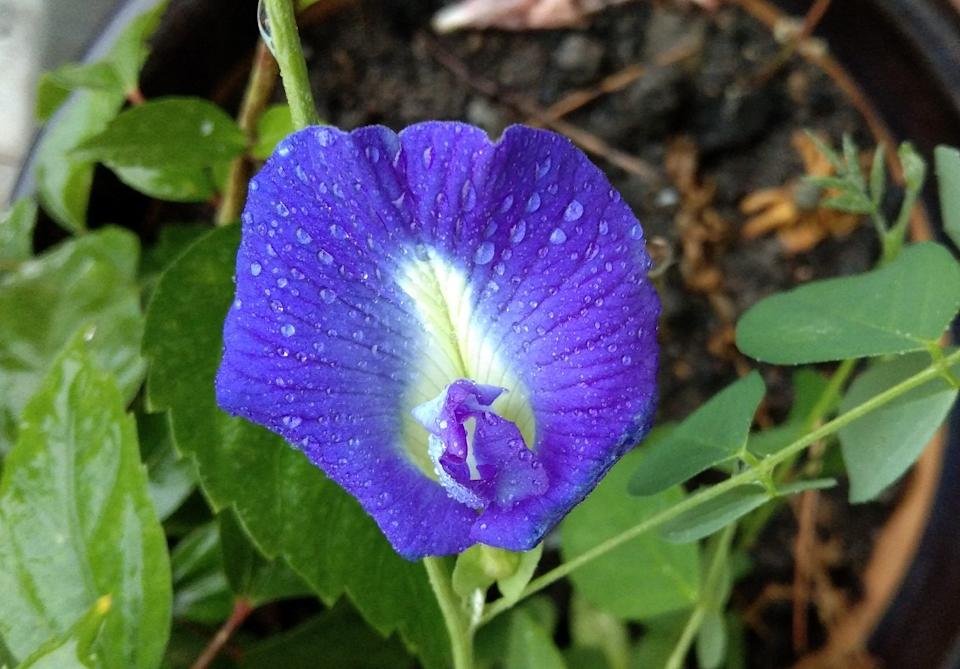Shankhapushpi or Butterfly Pea (Clitoria ternatia) is called ‘Medhya Rasayana’ (brain tonic) in Ayurveda – a medicine that rejuvenates, retains and potentiates intelligence and memory.

Shankhpushpi is one of the widely marketed herbal products in India for brain stimulation. The powerful antioxidants of this plant help in concentration and calm your brain. This can be beneficial for students during their exam preparation. In other words, it is a brain tonic.
Also known as Asian pigeons, Aparajita, Shankhaphuli, Shankhini, is a perennial plant of India. In English it is known as Morning-Glory, Speed Wheel or Aloe Weed. This medicinal herb has arrow-shaped leaves and bulb-shaped blue or white flowers. The name Shankhapushpi was given to the plant because of its conch or conch shaped flowers.
In English it is known as Morning-Glory, Speed Wheel or Aloe Weed. This medicinal herb has arrow-shaped leaves and bulb-shaped blue or white flowers. The name Shankhapushpi was given to the plant because of its conch or conch shaped flowers.
In English it is known as Morning-Glory, Speed Wheel or Aloe Weed. This medicinal herb has arrow-shaped leaves and bulb-shaped blue or white flowers. The name Shankhapushpi was given to the plant because of its conch or conch shaped flowers.
Known in Sanskrit as Mangalyakushum which means good luck and bringing health, each part of this plant is highly beneficial for treating many diseases including stress and anxiety, insomnia and diabetes. It reduces mental fatigue caused by long hours of work and excessive time on screen. By its use, there is an improvement in balance and dosha in Kapha-Vata-Pitta dosha and the herb is astringent and bitter.
The fresh plant gives light yellow oil with green color and a distinct smell by the process of steam distillation.
This memory enhancing herb is a magical remedy for many mental diseases such as epilepsy, dementia, Alzheimer’s as it prevents the destruction of neurons and improves cognitive function.
According to a cognitive vitality report written by neuroscientists at the Alzheimer’s Drug Discovery Foundation (ADDF), the calming effect of conch shell is thought to be mediated by the regulation of stress hormone production (eg, adrenaline and cortisol). This medicinal herb contains many bioactive phytoconstituents responsible for nootropic and other activities, such as alkaloids, flavonoids, and coumarins.
These compounds are believed to contribute to some other pharmacological activities as well as its nootropic and memory enhancing properties. It is also believed that a paste prepared from its roots and flowers acts as an anti-aging agent. In the cosmetic industry, Shankhpushpi is used as a tonic to rejuvenate skin and hair.
- Benefits of Shankhpushpi
- Reduces mental fatigue
- Digestion
- Treats depression
- Insomnia
- Anti oxidant
- Epilepsy
- Rejuvenates skin and hair
Shankhpushpi leaves were traditionally used to treat chronic bronchitis and asthma; The roots were used to cure childhood fever and used oil extracted from the plant to stimulate hair growth. The flower is also used to make fresh herbal teas. It is one of the best herbs to nourish all layers of the skin. The ethanolic extract of the plant reduces total serum cholesterol and fatty acids thus reducing the risk of heart disease.
Each part of this plant is highly beneficial for treating many diseases including stress and anxiety, insomnia and diabetes. It also reduces mental fatigue caused by long hours of work and excessive time on screen.
There are four different plant species by the name of Shankhapushpi, which are used in various Ayurvedic prescriptions, alone or in combination with other herbs. Shankhpushpi is widely available in the market in various forms such as gutika, powder or powder, juice or kashayam, syrup or arishtam, tablets or capsules known as Telam or Telam. But mostly it is used as sugar syrup.
Shankhpushpi leaves were traditionally used to treat chronic bronchitis and asthma; The roots were used to cure childhood fever and used oil extracted from the plant to stimulate hair growth. The flower is also used to make fresh herbal teas. It is one of the best herbs to nourish all layers of the skin. The ethanolic extract of the plant reduces total serum cholesterol and fatty acids thus reducing the risk of heart disease.
Each part of this plant is highly beneficial for treating many diseases including stress and anxiety, insomnia and diabetes. It also reduces mental fatigue caused by long hours of work and excessive time on screen.
Each part of this plant is highly beneficial for treating many diseases including stress and anxiety, insomnia and diabetes. It also reduces mental fatigue caused by long hours of work and excessive time on screen.
There are four different plant species by the name of Shankhapushpi, which are used in various Ayurvedic prescriptions, alone or in combination with other herbs. Shankhpushpi is widely available in the market in various forms such as gutika, powder or powder, juice or kashayam, syrup or arishtam, tablets or capsules known as Telam or Telam. But mostly it is used as sugar syrup.
Shankhpushpi has a mild blood pressure lowering effect, so people suffering from low blood pressure, or those taking anti-hypertensive drugs should consult their healthcare providers before taking it. It also interacts with the anti-seizure drug phenytoin.
Read in Hindi

